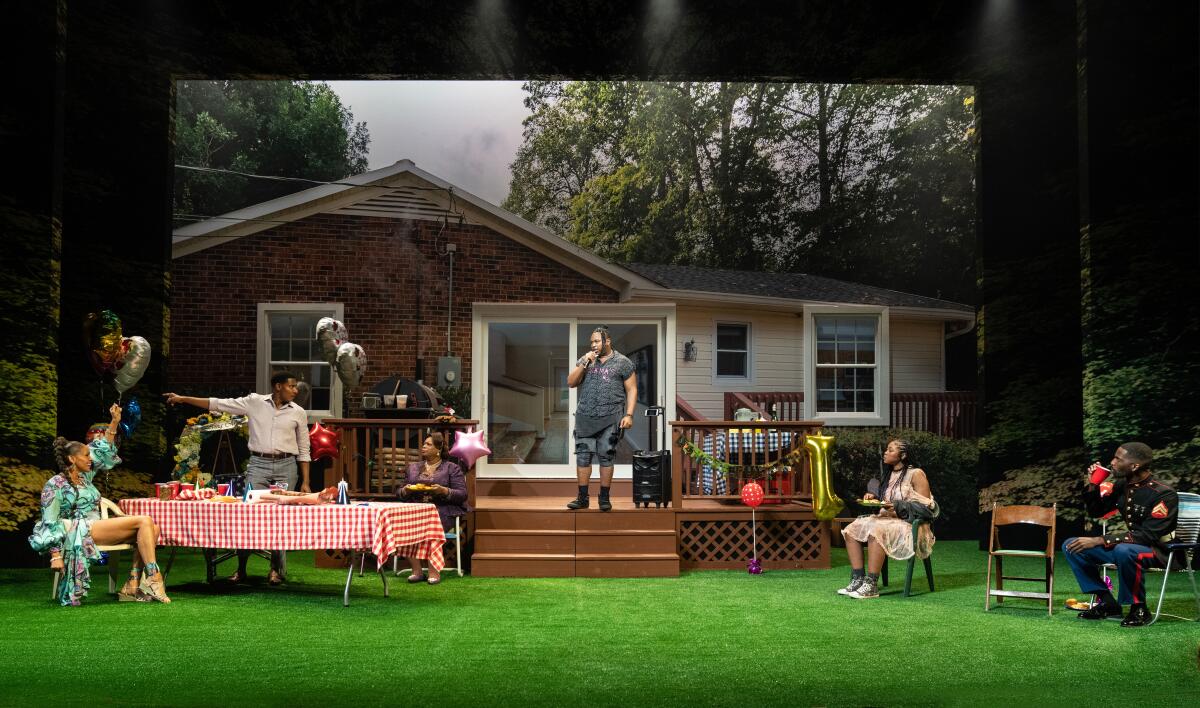Commentary: Why the Tony Awards should give one to the audience this year

Theater audiences have been getting attacked from all sides since venues reopened.
Broadway producers and artistic directors are angry that they’re not showing up in pre-pandemic numbers. Critics are complaining that their conservative taste is holding the American theater back. Actors, resuming their war on phones and hard candy now that masks are no longer required, are up in arms about bad etiquette. Patti LuPone has loudly lamented the distracted, “dumbed down” audience for Broadway, which she says is becoming more like “Disneyland, a circus and Las Vegas.”
At the start of my theater trip to New York this spring — an exhausting eight-show itinerary in 5½ days — I met my niece for a matinee of “Life of Pi.” It was pell-mell outside the Gerald Schoenfeld Theatre on West 45th Street. Horns were blaring, crowds were swarming and security was shouting for ticket-holders to get in the right line.
I joked, in curmudgeon uncle fashion, that the worst part of my job is sometimes the public. But after my marathon of shows, I left town with enormous gratitude to my fellow theatergoers for their genuine laughter, the seriousness of their attention, the generosity of their emotion and the graciousness of their applause.
Theater is both an art form and a marketplace, and Broadway ticket-buyers have long been getting a raw deal. Beyond the ludicrous cost of admission, the gouging at concessions, the transportation hell, the inadequate bathroom facilities and the torture-chamber seats, there’s the general contempt thrown at theatergoers for not knowing what’s good for them.
Attention must be paid to the core audience that has stuck it out and been filling these doddering old venues with their seasoned laughter and empathy. The Tony Awards on Sunday really ought to add one more prize to the evening’s roster — a special award to the stalwart Broadway theatergoer, without whom all of the year’s celebrated excellence would be as meaningless as the proverbial tree falling in a forest with no one around to hear it.
The musical “Some Like It Hot” led with 13 Tony nominations. “Kimberly Akimbo,” the critical pick for best musical, received 8. Tom Stoppard’s play “Leopoldstadt,” “Ain’t No Mo’” and the revival of “A Doll’s House” garnered six nods each.
There’s no sound in showbiz quite as crackling as a packed Broadway house. Arenas are certainly louder and stadiums more boisterous, but it’s hard to beat a theater crowd when it comes to ironic alertness and urbane discernment. Virtuosity among this set isn’t merely acknowledged but formally recognized.
When Lea Michele took over the role of Fanny Brice in the revival of “Funny Girl” at the start of the fall season, the electricity in the audience could have powered the entire theater district. Michele was delivering a tour de force, but the energy that was coming off the stage at the August Wilson Theatre was being returned with interest. There was a widespread awareness that something momentous was taking place. Everyone seated around me — the great majority of whom paid a king’s ransom to be there — understood just how lucky they were to experience this perfect confluence of performer and role.
I had a similar sense that something extraordinary was unfolding on that same trip last October when I saw “Leopoldstadt,” Tom Stoppard’s Tony-nominated epic drama about a culturally engaged Jewish family in Vienna that’s nearly completely wiped out in the Holocaust. This is a work that only Stoppard could have written. I say this not because of the play’s autobiographical origins but because of its grand verbal design, which captures the shifting European zeitgeist in what can only be described as a series of conversational oil paintings.
Tuned in to the historical pathos, the audience was just as attentive to the wit of Stoppard’s dialogue, not wanting to miss a beat of the banter, which resurrects in glistening theatrical form a vanished world. The atmosphere of hushed reverence was only heightened by the intellectual humor of an octogenarian playwright at the top of his game. Stoppard’s expansive vision was rewarded with a Broadway reception that matched the depth of the drama.
New York audiences have seen their fair share of productions of Stephen Sondheim and James Lapine’s “Into the Woods.” But Lear deBessonet’s revival (heading to the Ahmanson Theatre later this month) made this musical deconstruction of classic fairy tales seem newly minted.
The humor was so fresh and the direction so revitalizing that the revival was able to accommodate a rotating cast. By the time I saw the production around the Christmas holidays, Sara Bareilles, who played the Baker’s Wife, was no longer in the company. But her replacement was none other than Tony winner Stephanie J. Block, one of the most resplendent musical theater talents working today.
This was truly an ensemble affair, but a few performances left indelible impressions. Brian d’Arcy James in all his magnificent drollery as the Baker; Gavin Creel, endowing both the predatory Wolf and Cinderella’s foppish Prince with distinctive swagger; Joaquina Kalukango, blasting the Witch’s anthems to the dark skies above; and hilarious Katy Geraghty as the brashest Little Red Riding Hood I’ve ever seen frolicking to grandmother’s house in the woods.
Forgive me for leaving out the other cast members (Alysia Velez’s Rapunzel, Joshua Henry’s Rapunzel’s Prince!) who regardless of when they joined the production were part of a seamless whole. But one invaluable theatrical partner can’t be left out — the audience, whose vocal delight made this theatergoing experience at the St. James Theatre the best holiday gift I received last year.
Actor Ben Platt and his ‘Parade’ co-stars said they won’t back down from telling Leo Frank’s story on Broadway after antisemitic protests.
“Parade” had by far the quietest Broadway house I encountered on my spring trip. Silence can sometimes be a sign of disengagement. This was hardly the case here.
Clearly audible at the Bernard B. Jacobs Theatre was the concentration of audience members who were following Alfred Uhry and Jason Robert Brown’s complex musical about the historic tragedy of Leo Frank (Ben Platt), a Jewish factory manager in the South who’s found guilty of heinous crimes and ultimately lynched after the case against him reveals enormous cracks.
Platt credits director Michael Arden with turning the trial into a collective act of witnessing. The way members of the company are positioned to take in the proceedings, Platt explained, invites the audience to do the same. Platt, who remains on stage throughout the intermission as a kind of human exhibition of injustice, said that by the end the actors and the audience have nearly become one.
On the opposite end of the decibel scale is the new revival of “Sweeney Todd: The Demon Barber of Fleet Street,” starring Josh Groban and Annaleigh Ashford at the Lunt-Fontanne Theatre. Groban’s adoring followers create a concert-like environment. The cheering begins even before Sweeney’s numbers have ended, so excited are fans to see Groban in the role of the homicidal barber in Sondheim and Hugh Wheeler’s musical thriller.
But rather than detract from the meticulousness of the performances, the enthusiasm only seems to elevate the caliber. I haven’t felt such vitality in a venue since “Hamilton” opened on Broadway in 2015. Thomas Kail, as it happens, directed both the Lin-Manuel Miranda musical and this satisfying revival, and credit goes to his canny deployment of seismic theatrical talent.
Ever modest, Groban insisted that the acclamation isn’t just for him. He chalked it up to the star power of the ensemble and the new audience that has been turning out.
“The thing that’s been such an incredible surprise to us is how many gasps and ‘Oh, my Gods’ we hear in the audience,” he said. “I’m lying there at the end and thinking, ‘Oh, they’ve never seen it before.’”

The theatrical science that allows energy to flow freely between proscenium stage and auditorium is expertly put to use in “Fat Ham,” James Ijames’ Pulitzer Prize-winning riff on “Hamlet” at the American Airlines Theatre. Marcel Spears, who plays Juicy, the Hamlet figure, regularly interrupts a backyard barbecue to fill the audience in on the neo-Shakespearean situation that’s rapidly reaching a boiling point.
Soliloquies can be performed in a way that keeps the audience at a distance. But Spears’ Juicy uses these fourth-wall breaches to invite the audience in. The tone is casual and comic, making it easy for us to let our guards down. But before we know it we’re being implicated in the question of whether a story necessarily has to be a tragedy. Do we have it in our power to choose comedy over catastrophe and thereby give ourselves another day to bungle along?
The communal spirit of of “Fat Ham” was a perfect way to conclude a trip that filled me with a refreshing feeling of camaraderie. While I still don’t enjoy long bathroom lines or dealing with compulsive texters and raucous latecomers, Broadway audiences deserve their own accolade for making the highs so much higher than they would otherwise have been this season. All the stress and strain of going to the theater subsides the moment the lights go down and a roomful of strangers collectively inhales in anticipation of magic.
More to Read
The biggest entertainment stories
Get our big stories about Hollywood, film, television, music, arts, culture and more right in your inbox as soon as they publish.
You may occasionally receive promotional content from the Los Angeles Times.













